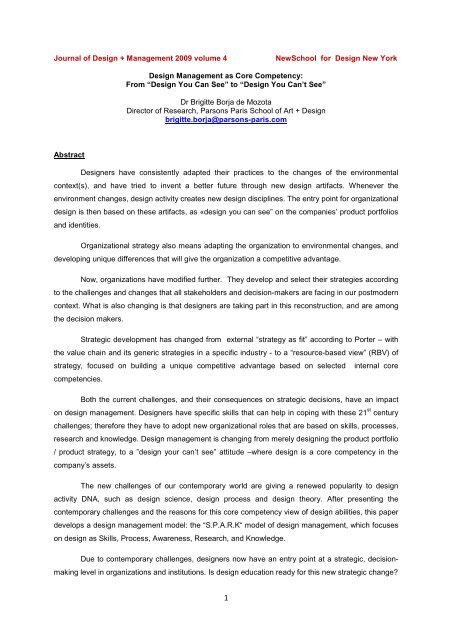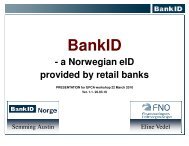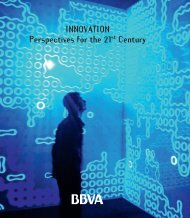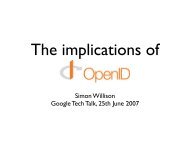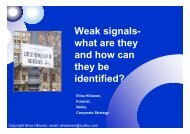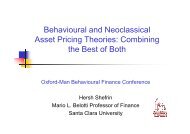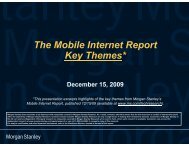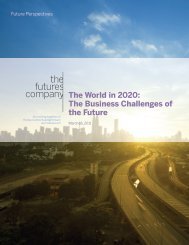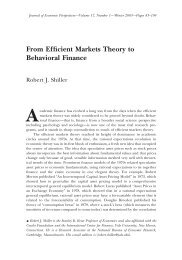Design Management as core competency
Design Management as core competency
Design Management as core competency
Create successful ePaper yourself
Turn your PDF publications into a flip-book with our unique Google optimized e-Paper software.
Journal of <strong>Design</strong> + <strong>Management</strong> 2009 volume 4<br />
NewSchool for <strong>Design</strong> New York<br />
<strong>Design</strong> <strong>Management</strong> <strong>as</strong> Core Competency:<br />
From “<strong>Design</strong> You Can See” to “<strong>Design</strong> You Can’t See”<br />
Dr Brigitte Borja de Mozota<br />
Director of Research, Parsons Paris School of Art + <strong>Design</strong><br />
brigitte.borja@parsons-paris.com<br />
Abstract<br />
<strong>Design</strong>ers have consistently adapted their practices to the changes of the environmental<br />
context(s), and have tried to invent a better future through new design artifacts. Whenever the<br />
environment changes, design activity creates new design disciplines. The entry point for organizational<br />
design is then b<strong>as</strong>ed on these artifacts, <strong>as</strong> «design you can see” on the companies’ product portfolios<br />
and identities.<br />
Organizational strategy also means adapting the organization to environmental changes, and<br />
developing unique differences that will give the organization a competitive advantage.<br />
Now, organizations have modified further. They develop and select their strategies according<br />
to the challenges and changes that all stakeholders and decision-makers are facing in our postmodern<br />
context. What is also changing is that designers are taking part in this reconstruction, and are among<br />
the decision makers.<br />
Strategic development h<strong>as</strong> changed from external “strategy <strong>as</strong> fit” according to Porter – with<br />
the value chain and its generic strategies in a specific industry - to a “resource-b<strong>as</strong>ed view” (RBV) of<br />
strategy, focused on building a unique competitive advantage b<strong>as</strong>ed on selected internal <strong>core</strong><br />
competencies.<br />
Both the current challenges, and their consequences on strategic decisions, have an impact<br />
on design management. <strong>Design</strong>ers have specific skills that can help in coping with these 21 st century<br />
challenges; therefore they have to adopt new organizational roles that are b<strong>as</strong>ed on skills, processes,<br />
research and knowledge. <strong>Design</strong> management is changing from merely designing the product portfolio<br />
/ product strategy, to a ”design your can’t see” attitude –where design is a <strong>core</strong> <strong>competency</strong> in the<br />
company’s <strong>as</strong>sets.<br />
The new challenges of our contemporary world are giving a renewed popularity to design<br />
activity DNA, such <strong>as</strong> design science, design process and design theory. After presenting the<br />
contemporary challenges and the re<strong>as</strong>ons for this <strong>core</strong> <strong>competency</strong> view of design abilities, this paper<br />
develops a design management model: the “S.P.A.R.K“ model of design management, which focuses<br />
on design <strong>as</strong> Skills, Process, Awareness, Research, and Knowledge.<br />
Due to contemporary challenges, designers now have an entry point at a strategic, decisionmaking<br />
level in organizations and institutions. Is design education ready for this new strategic change<br />
1
Introduction: Changes in design activity are linked to changes in the environmental context<br />
<strong>Design</strong>ers have always been “actors of change “in society. Studying both the history of design<br />
and the history of organizations demonstrates how the environment shapes simultaneously the<br />
activities of designers and managers. Historical ph<strong>as</strong>es in organization theory follow the same<br />
framework of design theories and design processes. There are no changes in design or in business<br />
that are not derived from, or influenced by, changes -- whether social, technological or cultural.<br />
Consequently, there is constantly a contradiction between the reality of the design activity<br />
(through design projects cl<strong>as</strong>sified under many design disciplines, namely ‘tangible design’, or “design<br />
you can see”) and the definition of the design activity (that emph<strong>as</strong>izes design science, design ethics<br />
and processes, design theory -- all intangible design attitude or ways of working, “design you can’t<br />
see”).<br />
As an example, see the present failure of “eco-design” which h<strong>as</strong> not been sufficiently<br />
powerful to change an economic system aimed at overconsumption. Few environmentally aware<br />
designers find a way to follow their consciences whilst thriving economically. Most designers at a<br />
professional level cannot follow their “Victor Papanek” consciences, and instead must apply their skills<br />
to market forces. <strong>Design</strong>ers should play a greater role in transforming society through more win-win<br />
relations on broader, supra systems - but how<br />
Managers and designers alike research changes in the world. From this research ph<strong>as</strong>e,<br />
designers discover new trends in technology and culture, and new needs in and for human behavior,<br />
which they embed in innovative cultural artifacts. Managers agree to develop these artifacts because<br />
they see their coherence with their own research on the global context of change. Just <strong>as</strong> designers<br />
are making new cultural routes tangible through their work, management are developing new strategic<br />
routes according to the new challenges in the outside environment.<br />
So what h<strong>as</strong> changed What are the changes in our postmodern context that all decision<br />
makers, including designers, have to face, andwhat are the challenges facing contemporary decision<br />
makers in society What is their potential, and impact, for and on design<br />
- Managing complexity: This requires applying “design thinking” <strong>as</strong> both a holistic view and <strong>as</strong><br />
“information design“; visualization skills are used to simplify complex environments, and to<br />
build scenarios for system change.<br />
- Globalization and innovation: Companies have to be international; design teams are used to<br />
multicultural working environments, and creativity h<strong>as</strong> no borders.<br />
- Process-oriented companies: Companies have to be more human-centred, customerdriven,<br />
and process-oriented; new information systems have to be invented for Customer<br />
Experience <strong>Management</strong>. <strong>Design</strong>ers have to take a wider view for “user oriented<br />
2
design”;customers are not the only focus and “users” must include customers <strong>as</strong> well <strong>as</strong><br />
employees, shareholders, suppliers, stakeholders, etc.<br />
- Socially Responsible Enterprises: This business model is spreading, and methods are<br />
needed in order to implement it <strong>as</strong> a collective action, <strong>as</strong> “sense building “according to<br />
K.Weick. <strong>Design</strong>ers’ input can go beyond “advanced design” projects in eco-design or<br />
community design, towards inventing and implementing standard processes for change in an<br />
SRE enterprise.<br />
As a consequence of these challenges, the design and design management communities have<br />
two directions for change: the incremental design strategy or “meta design” direction, and the radical<br />
“b<strong>as</strong>ic design“strategy - or <strong>core</strong> <strong>competency</strong> – direction.<br />
The “meta design” direction: incremental design strategy expanding “design you can see“<br />
Existing design disciplines have to redefine themselves according to the changes in the global<br />
context of the service - and aesthetics - b<strong>as</strong>ed economies:<br />
- The aesthetics-b<strong>as</strong>ed economy and the development of new design disciplines must include: design<br />
imaging, perception evaluation, cognitive psychology, ple<strong>as</strong>urable products and sensory design.<br />
- The service economy must develop: service portfolios, <strong>as</strong> well <strong>as</strong> services industries that redefine<br />
their activity in terms of customer experiences and customer relationships.<br />
The “experience economy“is where new “meta design” disciplines are needed, to help<br />
navigate between existing design-discipline silos. This “meta design“direction is an adaptation of<br />
design that is understood <strong>as</strong> design outputs and solutions. The entry points for design in organizations<br />
remain the same. The design demand starts with the company’s products and service portfolios, and<br />
the design brief is to give the brands an emotional difference that customers can see in the market.<br />
This direction is b<strong>as</strong>ed on the cl<strong>as</strong>sic strategy definition of Michael Porter: a strategy <strong>as</strong> fit in<br />
selecting a unique value chain in a specific market after a SWOT analysis of internal strengths and<br />
weaknesses, and the external opportunities and threats of your competition. <strong>Design</strong> is a tangible<br />
competitive advantage that is valued through improved sales, a brand image and market shares in a<br />
defined market.<br />
Finally, we have entered the “creative economy“ in which design is an industry that is part of<br />
the bigger picture of creative industries, and where creative industries are now understood <strong>as</strong> having a<br />
national competitive edge. Postmodern organizations are collages that value creativity. Managers in<br />
postmodern organizations are reinventing a management that enhances autonomy and individual<br />
creativity. <strong>Design</strong> managers in postmodern organizations enhance autonomy and individual creativity:<br />
3
co-design, user-centered design, inclusive design, etc. The postmodern design manager is seen <strong>as</strong> an<br />
artist or a theorist who focuses on creativity, freedom and individual responsibility.<br />
For example, the design manager focuses on self-entrepreneurship on “deconstructing<br />
hierarchical power“ through a galaxy of projects. <strong>Design</strong> isnow valued <strong>as</strong> giving voice to silence, or<br />
previously overlooked or unheard minorities.<br />
The <strong>core</strong> <strong>competency</strong> direction: radical design strategy <strong>as</strong> “design you can’t see“<br />
The traditional vision of strategy <strong>as</strong> fit is not helpful in solving the previously discussed<br />
challenges of decision makers. Therefore, another strategic theory h<strong>as</strong> emerged, emanating from a<br />
resource-b<strong>as</strong>ed perspective <strong>as</strong> well <strong>as</strong> a collective-learning objective. This RBV view of strategy<br />
focuses on internal development, but also on pushing the traditional boundaries of organizations<br />
through network management. This resource-b<strong>as</strong>ed theory of building a sustained competitive<br />
advantage h<strong>as</strong> developed since Wernerfelt’s article in 1984, which responded to the changes of<br />
organizations’ environments.<br />
A resource refers an <strong>as</strong>set or input to production that an organization owns, controls, or h<strong>as</strong><br />
access to on a semi-permanent b<strong>as</strong>is. Therefore, the resource-b<strong>as</strong>ed theory should be understood by<br />
design managers <strong>as</strong> a paradigm shift from the structure–conduct–performance (S-C-P) paradigm,<br />
where competitive advantage is primarily determined externally by environmental factors:<br />
differentiating from my competitors in an industry. This S-C-P view of design strategy is reactive. It is a<br />
tangible view of the company’s potential in regards to its competitive environment.<br />
Resource-b<strong>as</strong>ed management highlights how the possession of internal, valuable, rare,<br />
inimitable and non-substitutable resources may result in sustained superior performance. The<br />
Resource-B<strong>as</strong>ed View of a firm’s competitive advantage emph<strong>as</strong>izes the importance of the invisible<br />
internal <strong>as</strong>sets such <strong>as</strong> the skills and values of “design you can’t see”.<br />
Pralahad and Hamel argue that information-b<strong>as</strong>ed, invisible <strong>as</strong>sets -- such <strong>as</strong> technology,<br />
customer trust, brand image, corporate culture and management skills -- are the real resources of<br />
competitive advantage, because they are both difficult and time consuming to accumulate, and may<br />
also be used in multiple ways simultaneously. To design managers, it means promoting design<br />
abilities <strong>as</strong> rare, inimitable, and non-substitutable; it also means managing design with a long-term<br />
perspective of sustained, competitive advantage rather than a short-term view of project management.<br />
It is refocusing on design <strong>as</strong> being skills that are pertinent – even essential -- in developing a<br />
corporation’s intangible <strong>as</strong>sets.<br />
A more process oriented view of strategy in the new millennium part of the<br />
strategic discourse embraced a reconstruction view in which market<br />
boundaries and industries can be reconstructed by actions and beliefs of<br />
industry players.– (Johansson &Woodilla 2009)<br />
4
See also the so-called Kim and Mauborgne “Blue Ocean strategy”, which creates an<br />
uncontested market space that makes competition irrelevant. Strategy is dynamic, rather than solely<br />
concentrated on the competitors. In this process the view of strategy is to valorize; design<br />
management focuses on design process management rather than design project management.<br />
(Figure 1)<br />
Figure 1:The design process in business: the design function (Borja de Mozota 2006)<br />
The excitement surrounding “design thinking”, <strong>as</strong> well <strong>as</strong> the new MBA often praised by Roger<br />
Martin in business media, is a good example of this radical design strategy. So why should designers<br />
now return to the b<strong>as</strong>ic, “what is design“ activity Quite simply, it is the skills of the designers that will<br />
help decision makers facing their current challenges. The entry point for design within organizations is<br />
not only the object to be designed for the company portfolio, but rather it is some specific skills of<br />
designers.<br />
Figure 2 is a synthesis of designers’ skills, and -- in italics -- the skills that are most relevant to<br />
our present context:<br />
5
Knowledge Attitude Values Applied skills Understanding<br />
skills<br />
<strong>Design</strong> process<br />
Risk-taking<br />
Managing uncertainty<br />
Practical design skills<br />
Prototyping<br />
Drawing ability<br />
Observation<br />
Material Originality Creative techniques Researching<br />
Lateral thinking<br />
Market Anticipating future Commercial skills Logical thinking<br />
trends<br />
Forward thinking<br />
Technology Proactive in Communication skills Analyzing<br />
developing<br />
(Presentation and Prioritizing<br />
relationships<br />
report writing) Structuring problems<br />
User awareness Open-minded Computer skills Scenario building<br />
Narrative<br />
Culture<br />
Understanding <strong>Design</strong><br />
for Synthesizing<br />
multidisciplinary manufacture<br />
Holistic thinking<br />
context<br />
Aesthetic awareness Focusing on usability Project management Intuitive thinking &<br />
action<br />
Human factors Attention to detail Optimization Consumer and<br />
stakeholder needs<br />
Manufacturing<br />
process<br />
Learning from errors Team work Human empathy<br />
Figure 2: <strong>Design</strong> skills: in italics, the strategic skills for now<br />
And one of most important skill is “holistic thinking” or the designers curiosity, their open-mindedness<br />
that transcends existing barriers of industries silos .<br />
The design agency IDEO h<strong>as</strong> branded designers’ skills under the term “design thinking”, and<br />
their global success -- the Davos summit, Procter & Gamble, the design school that they have opened<br />
at Stanford University -- is evidence of the coherence between their discourse with the needs of both<br />
CEOs and politicians worldwide. <strong>Design</strong> science <strong>as</strong> entrepreneurial science on a society and world<br />
level.<br />
This, therefore, is where we must to return to our introductory remark on the contradictions in<br />
the design community, between the reality and the definition of the design profession. In the design<br />
community, and particularly among academics in design, everyone is familiar with: Simon’s design<br />
science, Donald Schon’s reflexive practitioner, and Willemien Visser’s vision of design <strong>as</strong> a<br />
construction of representations. Writers such <strong>as</strong> Bryan Lawson or Nigel Cross have explained<br />
designers’ ways of knowing and of thinking. Indeed every designer will probably refer individually to<br />
one or more of these concepts: design activity <strong>as</strong> problem solving, <strong>as</strong> part of the industrial process, <strong>as</strong><br />
social engineering, <strong>as</strong> a question, <strong>as</strong> a research activity, <strong>as</strong> a discourse rather than a thing, <strong>as</strong> a label,<br />
6
<strong>as</strong> an art form, etc. Why, therefore, is it that our current context requires us to return to the most b<strong>as</strong>ic<br />
of design definitions<br />
<strong>Design</strong> science is what is needed to change the strategic definition process within companies.<br />
Strategy definition is also becoming a complex and “wicked problem”; comparing and competing with<br />
one’s rivals on market share targets in well documented, static industrial sectors will provide no<br />
sustained advantage. This is not the way the economy is working now, after the digital revolution.<br />
Where is your “competition“ when industries’ frontiers are blurring, when Amazon and Google<br />
are the new entrants’ competition for traditional industries such <strong>as</strong> editing, publishing and general<br />
commerce Consequently, all strategic methods b<strong>as</strong>ed on competition analysis, whether used by<br />
designers or by managers, are less and less relevant <strong>as</strong> decision-making tools.<br />
In this transitional economy, where any individual on the Internet is challenging the role of<br />
institutions to regulate the economy, new skills are needed to innovate in your relationship to the<br />
world. <strong>Design</strong> activity becomes an agent of change for prototyping the new socio-technical system that<br />
h<strong>as</strong> to be invented, <strong>as</strong> well <strong>as</strong> for helping companies manage the transition between the old, and the<br />
emerging socio-technical systems.<br />
Recently, the way that designers think h<strong>as</strong> become incre<strong>as</strong>ingly interesting to business<br />
managers because it is often seen <strong>as</strong> creative and holistic rather than specialist and bureaucratic.<br />
(See Figure 2: designers ’skills.)The emerging roles for designers in the 21st century, according to the<br />
previously discussed challenges in a complex world of stakeholders are: (Inns2007)<br />
-<strong>Design</strong> <strong>as</strong> a facilitator of thinking: the designer in the 21 st century will need to know how to mobilize<br />
and energize the thinking of others.<br />
-<strong>Design</strong> <strong>as</strong> a visualizer of the intangible: not a new role but an extended one, visualization of systems,<br />
relationships, emotions, experiences and networks.<br />
-<strong>Design</strong> <strong>as</strong> a navigator of complexity: in a world of complexity and ambiguity, designers have to<br />
understand complexity theory in order to help others understand complexity.<br />
- <strong>Design</strong>er <strong>as</strong> a mediator of stakeholders:“meta design” with tools that can allow multiple stakeholders<br />
to debate a complex issue.<br />
-<strong>Design</strong> <strong>as</strong> a coordinator of exploration: coordinate the exploration of relevant technical and contextual<br />
sources to maximize creativity in the early stages of a design.<br />
What are these new challenges, and why is design the best solution<br />
Understanding the link between design <strong>as</strong> a <strong>core</strong> <strong>competency</strong> and the new “person-centric<br />
“economy may be seen through two examples: the healthcare industry and the travel industry.<br />
7
How might design inform healthcare and vice versa <strong>Design</strong> tends to be person–centric, while<br />
healthcare is rather pathology-centric. However, individuals have less revenue for managing illness in<br />
the new economy, so they take care of themselves differently and/or they wish to avoid hospitals. It is<br />
therefore no longer the illness or pathology --such <strong>as</strong> diabetes -- that defines the medical industry, but<br />
rather the individual suffering from this long term illness. How can he or she co-design his or her own<br />
way of living with the pathology within a person-centric system and entrepreneurial attitude<br />
Consequently, we find the rise of service design, co-design/inclusive design, system design, platform<br />
design, etc. in national healthcare systems worldwide.<br />
Another example is seen in the travel industry. Traditionally it w<strong>as</strong> organized by where you<br />
wanted to travel, how you wanted to travel -- train, car, plane—and how much you wanted to pay for<br />
your hotel room. Now, simply by looking into the number of occurrences in Google searches, you will<br />
see websites answering these traditional segmentation criteria; however the most frequently cited<br />
websites are referring to a new criterion --travelling alone. So “being alone” is a new segmentation<br />
criterion for travel, but could also be used for innovative ways in arranging service industries. After all,<br />
you may be alone at some time of your life for many different re<strong>as</strong>ons: hence the rise of the<br />
“concierge“ services successes.<br />
Therefore I -- first <strong>as</strong> a person, then <strong>as</strong> a person being “alone” -- am reconstructing many<br />
different industries, and pushing alliances between traditionally competing actors. Consequently, in<br />
this individual economy – the DOWN/UP economy–the brand power of organizations is fundamental in<br />
shaping our mental images that this brand, rather than another brand, is best for ME regardless of<br />
whatever product or services it offers. The power is in “ME” <strong>as</strong> a human being, with the power of<br />
individual choice.<br />
The “complexity economy” means adopting this “DOWN/UP”, person-centric attitude. This,<br />
therefore, is the re<strong>as</strong>on for the “design thinking“, user-driven design attitude: an empathetic attitude<br />
gives designers new roles. <strong>Design</strong>ers’ research skills and attitudes mean that the design profession<br />
can embrace larger issues such <strong>as</strong> social innovation and, <strong>as</strong> such, invent new business models.<br />
<strong>Design</strong>ers and strategists share an entrepreneurial spirit.<br />
<strong>Design</strong>ers need to explore how design knowledge might be exported and imported across the<br />
traditional borders of design. A key question to consider is:”Can designers industrialize socially<br />
responsible solutions” (Morelli,2007)<strong>Design</strong>ers need to understand the concepts and values of their<br />
skills in order to design from outside the traditional boundaries.<br />
<strong>Design</strong> <strong>Management</strong> <strong>as</strong> <strong>core</strong> <strong>competency</strong><br />
What h<strong>as</strong> changed in <strong>Design</strong> <strong>Management</strong>, from seeing design primarily <strong>as</strong> design strategy<br />
and managing design projects, to recognizing design <strong>as</strong> an integral function of all organizations In<br />
becoming a function of organizations, design can be selected <strong>as</strong> a <strong>core</strong> <strong>competency</strong>. Our model<br />
<strong>Design</strong>ence (Borja de Mozota 2006) h<strong>as</strong> given evidence for four types of design values; ”design you<br />
8
can’t see “ through the managerial process value of design and the transformational value of design<br />
skills have now been well-documented.<br />
Our <strong>as</strong>sumption is that designers should change from their focus on product and service<br />
portfolio or product strategy and from design discipline-centered views of their territory.<br />
Example: Current <strong>Design</strong> territory in organizations to be expanded :(Moultrie et al, 2008).<br />
-<strong>Design</strong> in the communication, promotion and delivery of products and services and in the creation<br />
and communication of the identity of the business.<br />
-<strong>Design</strong> <strong>as</strong> the creation of products and services.<br />
-<strong>Design</strong> within the business: design of the organization’s operating environment workplaces, design of<br />
business processes and systems.<br />
<strong>Design</strong> is an <strong>as</strong>set giving value to other intangible <strong>as</strong>sets in organizations. This <strong>core</strong><br />
<strong>competency</strong> view of design is b<strong>as</strong>ed on the design profession’s myriad capabilities. The changes in<br />
the global context have created a new model of postmodern organizations, where designers have new<br />
roles to play. <strong>Design</strong> skills are for reinventing new business models.<br />
Rather than seeing the present system <strong>as</strong> more complex, it is the system that h<strong>as</strong> to be<br />
reinvented. New business models and new industries will emerge that will change the balance of our<br />
socio-technical system. Also, in this transition period, “design thinking” <strong>as</strong> holistic and “user oriented“<br />
will coax the change. <strong>Design</strong>ers’ empathy is a key factor. Nonetheless, holistic systemic thinking for<br />
inventing value for all stakeholders is in concordance with the shift in strategy definition (Borja de<br />
Mozota & Kim 2009, Figure 3).<br />
9
Figure 3:From design strategy <strong>as</strong> fit to design strategy <strong>as</strong> a resource (Borja de Mozota& Kim 2009)<br />
What h<strong>as</strong> changed in management is the emergence of a mental image of design <strong>as</strong> a<br />
horizontal function in organizations and institutions. B<strong>as</strong>ed on Skills (figure 1),on Process (figure 2), on<br />
Awareness, on Research and on Knowledge for improving organizations’ capital -- whether human,<br />
knowledge, cultural, or technological (figure 3) -- we call this <strong>Design</strong> <strong>Management</strong> model the<br />
S.P.A.R.K model of <strong>Design</strong> <strong>Management</strong> (Borja de Mozota & Dong 2009).<br />
Conclusion<br />
Unlike managing design <strong>as</strong> a competitive advantage, managing design <strong>as</strong> a <strong>core</strong> <strong>competency</strong><br />
is high-risk and needs long-term vision; therefore many companies have been reluctant to invest in<br />
building design capabilities. However, some companies have understood that building a sustainable,<br />
competitive advantage requires adopting a long-term resource view of design management in order to<br />
improve the probability of success in the present chaotic business environment.<br />
Managers have to integrate design theories in their organizational al theories, and see “design science”,<br />
design theories and conceptual models <strong>as</strong> skills for designing their organizational platforms, structures<br />
and organizational studies.<br />
10
The problem, however, is that even though designers have this potential to work at a higher<br />
strategic level of organization, they are not yet trained to do so. This is a challenge for design<br />
education. <strong>Design</strong>ers have to reinvent the guilds, and to become more effective entrepreneurs in order<br />
to help society at large to face the changes in this transitional period between two socio-technical<br />
systems. They also have to design their profession <strong>as</strong> a part of the creative industries.<br />
References<br />
Borja de Mozota, Brigitte. “The four powers of design:A value model in <strong>Design</strong> <strong>Management</strong>”.<strong>Design</strong><br />
<strong>Management</strong> Review. Volume 17 (Spring 2006), pp 42-53.<br />
Borja de Mozota, Brigitte and Kim Bo Young. “Managing <strong>Design</strong> <strong>as</strong> a Core Competency:Lessons from<br />
Seven Korean companies”.<strong>Design</strong> <strong>Management</strong> Review. (In press, 2009).<br />
Borja de Mozota, Brigitte and Dong Hua. “Towards a theory of <strong>Design</strong> <strong>Management</strong>:can theoretical<br />
models define its territory A transcultural conversation between design and business”. D2B2,<br />
<strong>Design</strong> To Business conference. Conference Paper. Tsinghua University, Beijing China. April<br />
2009.<br />
Inns Tom.(ed).<strong>Design</strong>ing for the 21 st century: interdisciplinary questions and insights. Gower: 2007,<br />
pp.21-26.<br />
Johansson, Ulla and Jill Woodilla.“Towards an epistemological merger of design thinking,strategy<br />
and innovation”. 8 th European Academy of <strong>Design</strong> conference. Conference Paper. The Robert<br />
Gordon University,Aberdeen Scotland. April 2009.<br />
Morelli, Nicola.“Social innovation and new industrial contexts:can designers “industrialize” socially<br />
responsible solutions”<strong>Design</strong> Issues. Volume 23 (Autumn 2007), pp 3-21.<br />
Moultrie, James et al. “<strong>Design</strong> funding in firms: a conceptual model of the role of design in industry“.<br />
International DMI Education Conference on <strong>Design</strong> Thinking. Conference Paper. ESSEC<br />
Business School, CergyPontoise,France. April 2008.<br />
Visser, Willemien, The cognitive artifacts of designing. Lawrence Erlbaum Associates, 2006. p. 116.<br />
11


